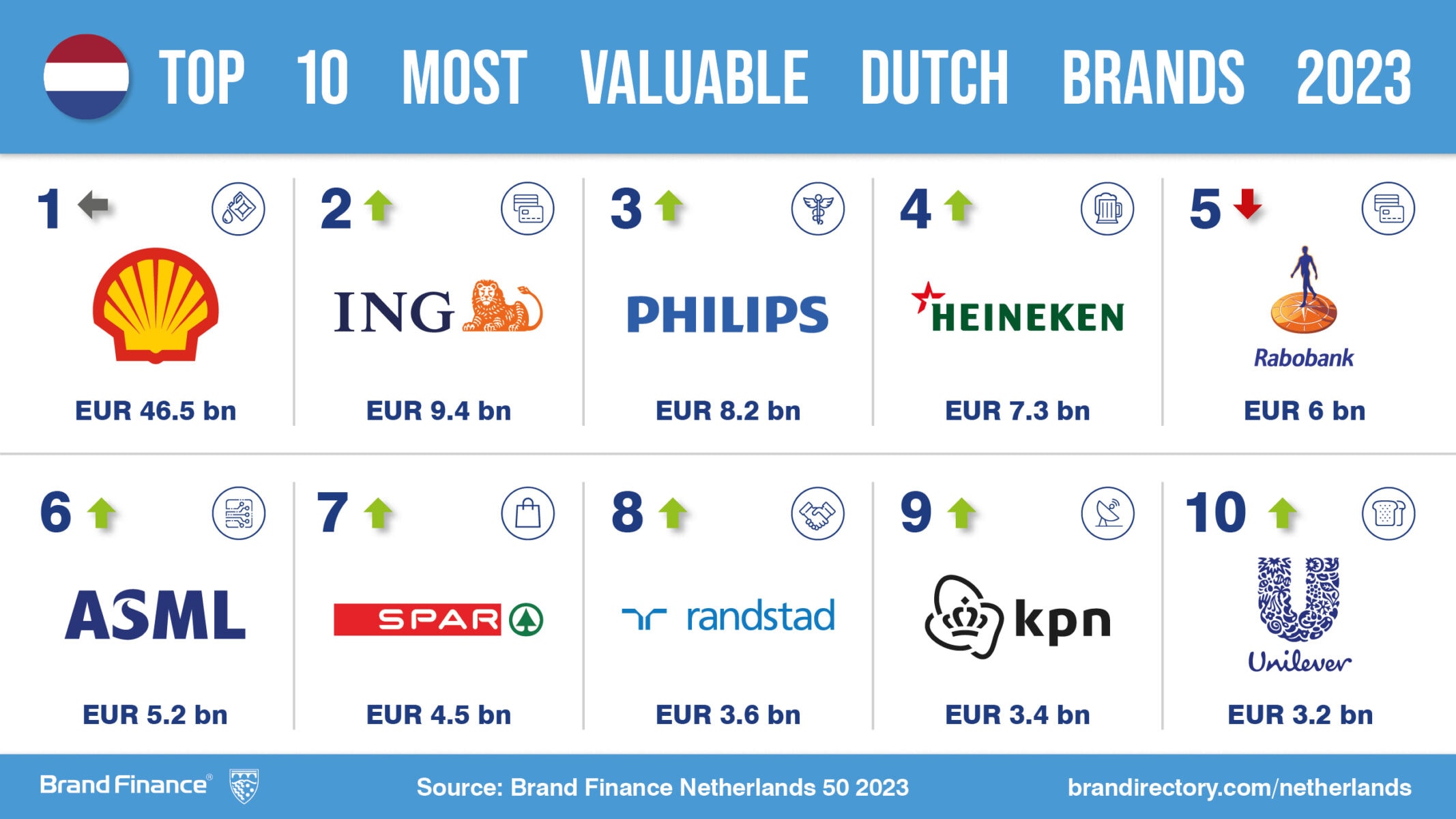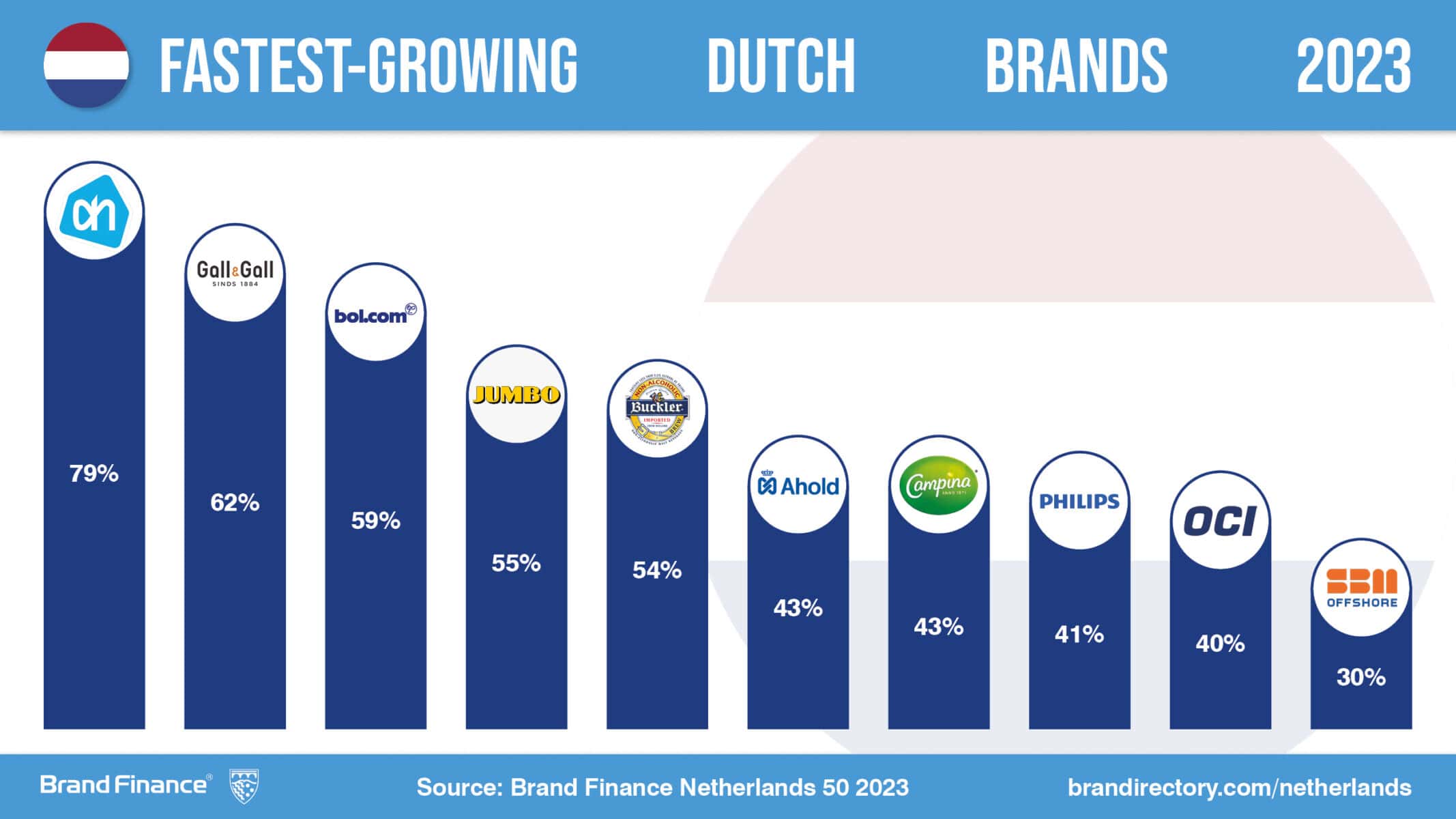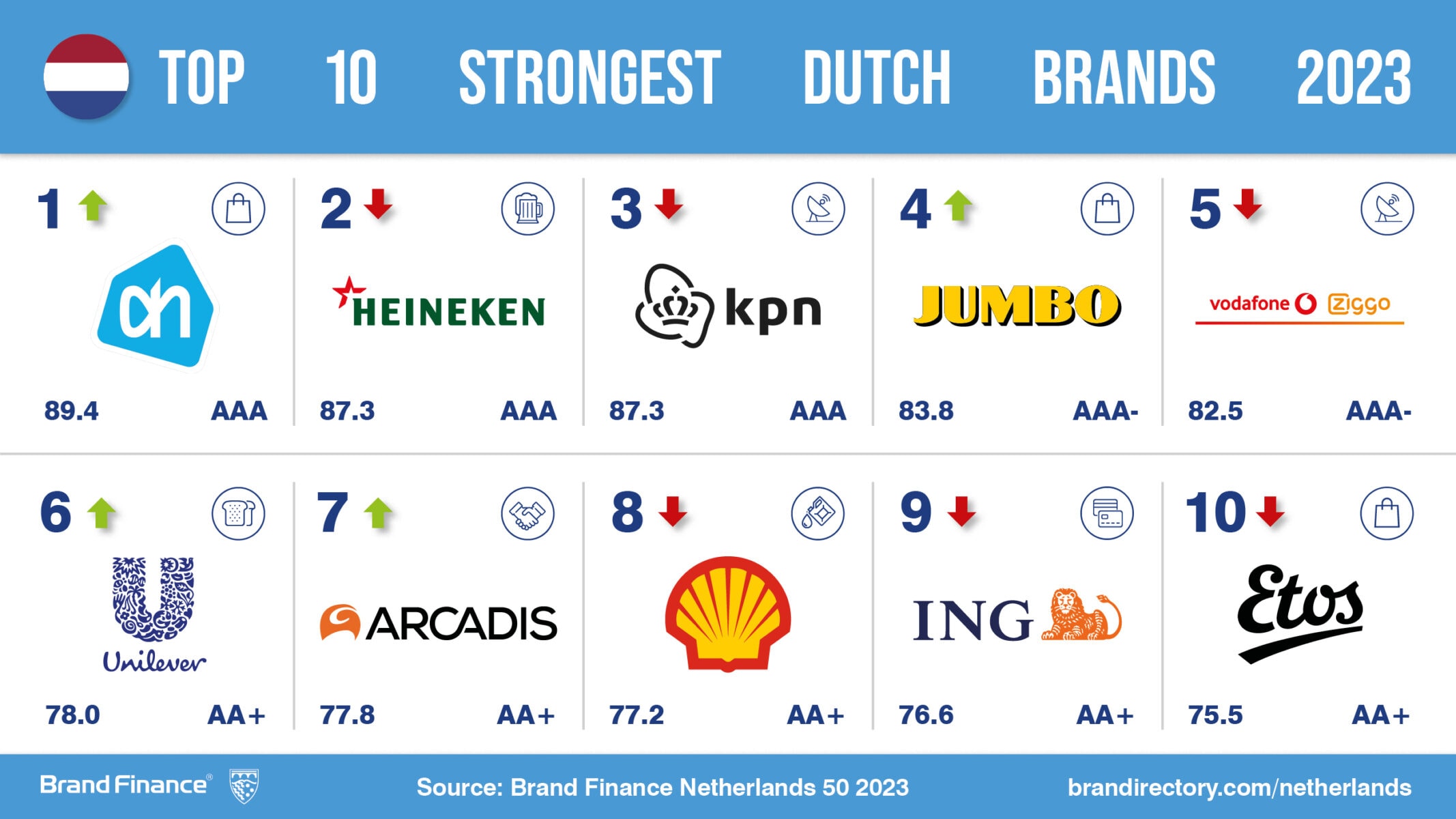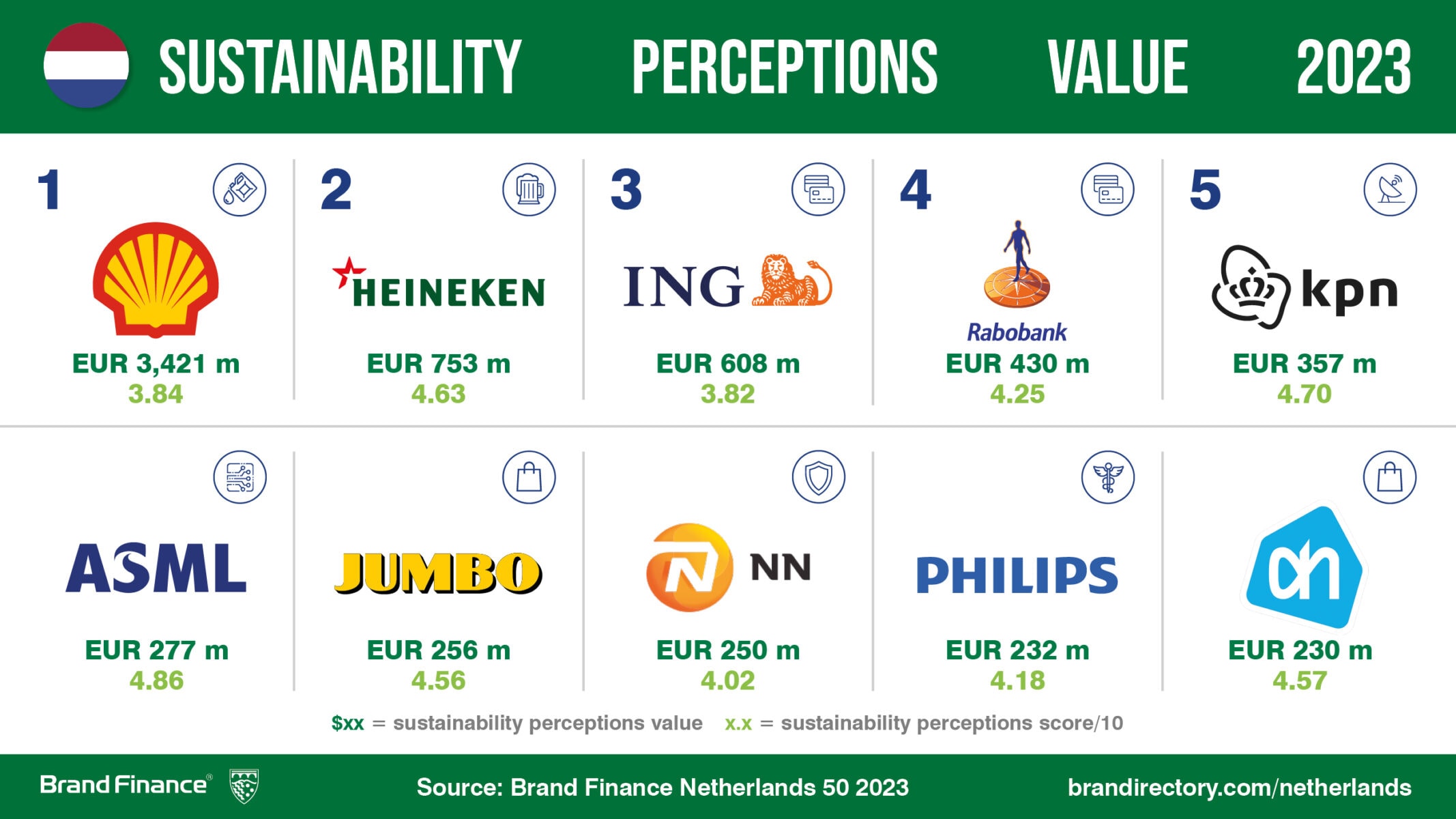View the full Brand Finance Netherlands 50 2023 report here
Shell (brand value up 8% to €46.5 billion) remains dominant in its position as the most valuable Dutch brand in 2023. Throughout the past year, Shell has taken a global leadership role in helping customers divest from Russia in the wake of Russia’s invasion of Ukraine and helped provide some degree of energy security to Europe.
Every year, leading brand valuation consultancy Brand Finance puts 5,000 of the biggest brands to the test, and publishes over 100 reports, ranking brands across all sectors and countries. The world’s top 50 most valuable and strongest Dutch brands and global brands with Dutch origins are included in the annual Brand Finance Netherlands 50 2023 ranking.
Annie Brown, General Manager, Brand Finance commented:
"Throughout the past year, Shell has enjoyed the advantages of soaring hydrocarbon prices, driven by disruptions in gas supplies and a surge in oil demand as global economies began to return to normalcy in the aftermath of the Covid-19 pandemic. However, despite record profits off the back of this, Shell’s decline in brand equity has tempered the company's growth in brand value, casting a revealing light on the complex dynamics shaping Shell's overall performance."

The Netherlands’ largest supermarket chain, Albert Heijn, is the fastest growing brand in the ranking, up 79% to a brand value of €1.7 billion. In the face of inflation and supply challenges in 2022, Albert Heijn's parent company, Ahold Delhaize, successfully implemented its 'Save for Our Customers' cost savings program. This initiative helped reduce the impact of rising food prices and enhance customer experience across its various brands, including Albert Heijn.
Albert Heijn has also formed a partnership with Jan Linders Supermarkets, planning to convert most its stores into Albert Heijn franchise locations. This collaboration enables Albert Heijn to extend its regional presence, particularly in the southern part of the Netherlands, broadening its dominance on the Dutch supermarket landscape and potentially further boost its strong growth trajectory moving forward.

In addition to calculating brand value, Brand Finance also determines the relative strength of brands through a balanced scorecard of metrics evaluating marketing investment, stakeholder equity, and business performance. Compliant with ISO 20671, Brand Finance’s assessment of stakeholder equity incorporates original market research data from over 100,000 respondents in 38 countries and across 31 sectors.
Albert Heijn has also risen ten places in the Brand Strength Index (BSI) ranking, becoming the strongest Dutch brand with a BSI score of 89.40 out of 100 and AAA rating. This increase in Brand strength is a key driver of Albert Heijn’s brand value growth.

The multinational online food ordering and delivery company, Just Eat Takeaway.com, lost more brand value that any other Dutch brand in 2023, dropping 47% year-on-year to €2.1 billion. The brand encountered a challenging backdrop in 2022 as consumer habits changed following the end of Covid-19 restrictions. This resulted in significantly lower order processing compared to 2021.
As part of its analysis, Brand Finance assesses the role that specific brand attributes play in driving overall brand value and how this varies by sector. One such attribute is sustainability. Brand Finance assesses how sustainable specific brands are perceived to be, represented by a ‘Sustainability Perceptions Score’. The value that is linked to sustainability perceptions, the ‘Sustainability Perceptions Value’, is then calculated for each brand.
Campina (brand value up 43% to €443 million), the Dutch dairy cooperative, has the highest Sustainability Perceptions Score of any brand included in the Netherlands 50 2023 ranking - 5.55 out of 10. This is also a stellar score when compared with other brands on the global stage. The brand's perceived commitment to sustainability is enhanced by its efforts to monitor and minimise its farmers' carbon footprint, preserve biodiversity, and uphold high standards of animal welfare. Campina has effectively communicated these initiatives to its stakeholders, resulting in a strong and positive perception of its sustainability practices.

Brand Finance is the world’s leading brand valuation consultancy. Bridging the gap between marketing and finance, Brand Finance evaluates the strength of brands and quantifies their financial value to help organisations make strategic decisions.
Headquartered in London, Brand Finance operates in over 25 countries. Every year, Brand Finance conducts more than 6,000 brand valuations, supported by original market research, and publishes over 100 reports which rank brands across all sectors and countries.
Brand Finance also operates the Global Brand Equity Monitor, conducting original market research annually on 6,000 brands, surveying more than 175,000 respondents across 41 countries and 31 industry sectors. By combining perceptual data from the Global Brand Equity Monitor with data from its valuation database — the largest brand value database in the world — Brand Finance equips ambitious brand leaders with the data, analytics, and the strategic guidance they need to enhance brand and business value.
In addition to calculating brand value, Brand Finance also determines the relative strength of brands through a balanced scorecard of metrics evaluating marketing investment, stakeholder equity, and business performance, compliant with ISO 20671.
Brand Finance is a regulated accountancy firm and a committed leader in the standardisation of the brand valuation industry. Brand Finance was the first to be certified by independent auditors as compliant with both ISO 10668 and ISO 20671 and has received the official endorsement of the Marketing Accountability Standards Board (MASB) in the United States.
Brand is defined as a marketing-related intangible asset including, but not limited to, names, terms, signs, symbols, logos, and designs, intended to identify goods, services, or entities, creating distinctive images and associations in the minds of stakeholders, thereby generating economic benefits.
Brand strength is the efficacy of a brand’s performance on intangible measures relative to its competitors. Brand Finance evaluates brand strength in a process compliant with ISO 20671, looking at Marketing Investment, Stakeholder Equity, and the impact of those on Business Performance. The data used is derived from Brand Finance’s proprietary market research programme and from publicly available sources.
Each brand is assigned a Brand Strength Index (BSI) score out of 100, which feeds into the brand value calculation. Based on the score, each brand is assigned a corresponding Brand Rating up to AAA+ in a format similar to a credit rating.
Brand Finance calculates the values of brands in its rankings using the Royalty Relief approach – a brand valuation method compliant with the industry standards set in ISO 10668. It involves estimating the likely future revenues that are attributable to a brand by calculating a royalty rate that would be charged for its use, to arrive at a ‘brand value’ understood as a net economic benefit that a brand owner would achieve by licensing the brand in the open market.
The steps in this process are as follows:
1 Calculate brand strength using a balanced scorecard of metrics assessing Marketing Investment, Stakeholder Equity, and Business Performance. Brand strength is expressed as a Brand Strength Index (BSI) score on a scale of 0 to 100.
2 Determine royalty range for each industry, reflecting the importance of brand to purchasing decisions. In luxury, the maximum percentage is high, while in extractive industry, where goods are often commoditised, it is lower. This is done by reviewing comparable licensing agreements sourced from Brand Finance’s extensive database.
3 Calculate royalty rate. The BSI score is applied to the royalty range to arrive at a royalty rate. For example, if the royalty range in a sector is 0-5% and a brand has a BSI score of 80 out of 100, then an appropriate royalty rate for the use of this brand in the given sector will be 4%.
4 Determine brand-specific revenues by estimating a proportion of parent company revenues attributable to a brand.
5 Determine forecast revenues using a function of historic revenues, equity analyst forecasts, and economic growth rates.
6 Apply the royalty rate to the forecast revenues to derive brand revenues.
7 Discount post-tax brand revenues to a net present value which equals the brand value.
Brand Finance has produced this study with an independent and unbiased analysis. The values derived and opinions presented in this study are based on publicly available information and certain assumptions that Brand Finance used where such data was deficient or unclear. Brand Finance accepts no responsibility and will not be liable in the event that the publicly available information relied upon is subsequently found to be inaccurate. The opinions and financial analysis expressed in the study are not to be construed as providing investment or business advice. Brand Finance does not intend the study to be relied upon for any reason and excludes all liability to any body, government, or organisation.
The data presented in this study form part of Brand Finance's proprietary database, are provided for the benefit of the media, and are not to be used in part or in full for any commercial or technical purpose without written permission from Brand Finance.